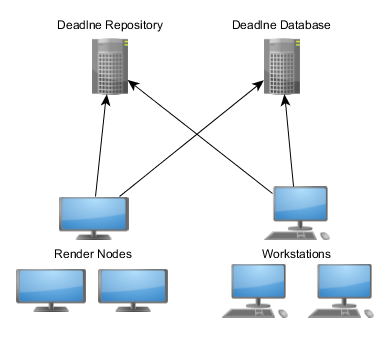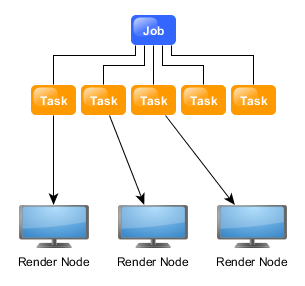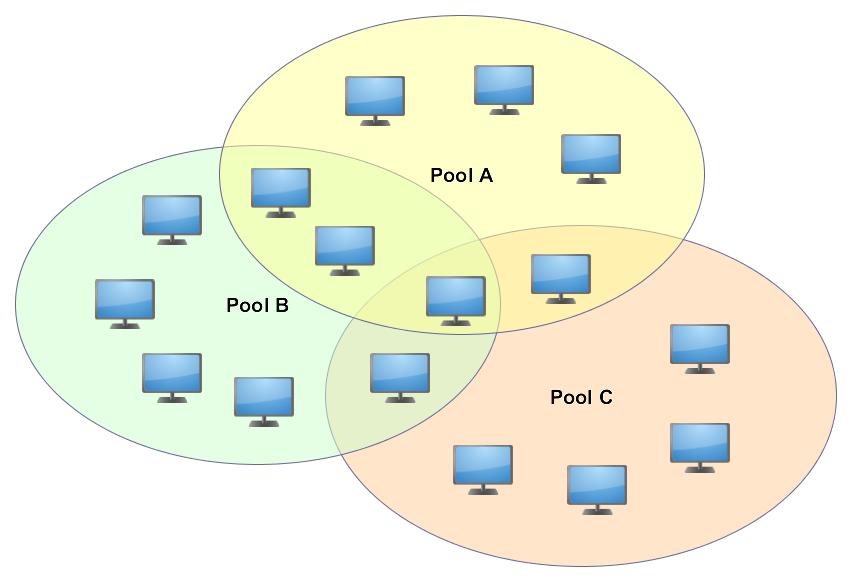Note
Looking for a render solution? Deadline Cloud is a fully managed service designed for studios building cloud-first pipelines. It eliminates the need to manage infrastructure such as repositories, databases, or license servers, and handles scaling, asset syncing, and usage-based licensing directly within AWS.
Overview¶
Deadline 10 is a cross-platform render farm management tool for Windows, Linux, and macOS. It gives users control of their rendering resources and can be used on-premises, in the cloud, or both. It handles asset syncing to the cloud, manages data transfers, and supports tagging for cost tracking purposes.
Deadline 10’s Remote Connection Server allows for communication over HTTPS, improving performance and scalability. Where supported, users can use usage-based licensing to supplement their existing fixed pool of software licenses when rendering through Deadline 10.
Components¶
The Deadline Render Farm Management System is built up of 3 components:
A single Deadline Database
A single Deadline Repository
One or more Deadline Clients
The Database and Repository together act as a global system where all of Deadline’s data is stored. The Clients (workstations and render nodes) then connect to this system to submit, render, and monitor jobs. It is important to note that while the Database and Repository work together, they are still separate components, and therefore can be installed on separate machines if desired.
Database¶
The Database is the global database component of the Deadline Render Farm Management System. It stores the jobs, settings, and Worker configurations. The Clients access the Database via a direct socket connection over the network. It only needs to be installed on one machine (preferably a server).
Repository¶
The Repository is the global file system component of the Deadline Render Farm Management System. It stores the plugins, scripts, logs, and any auxiliary files (like scene files) that are submitted with the jobs. The Clients access the Repository via a shared network path. It only needs to be installed on one machine (preferably a server).
Client¶
The Client should be installed on your render nodes, workstations, and any other machines you wish to participate in submitting, rendering, or monitoring jobs. The Client consists of the following applications:
Launcher: Acts as a launch point for the Deadline applications on workstations, and facilitates remote communication on render nodes.
Monitor: An all-in-one application that artists can use to monitor their jobs and administrators can use to monitor the farm.
Worker: Controls the rendering applications on the render nodes.
Command: A command line tool that can submit jobs to the farm and query for information about the farm.
Pulse: An optional mini server application that performs maintenance operations on the farm, and manages more advanced features like Auto Configuration, Power Management, Worker Throttling, Statistics Gathering, and the Web Service. If you choose to run Pulse, it only needs to be running on one machine.
Remote Connection Server: An optional application that handles HTTP or HTTPS connections to a remote repository for use by Deadline applications.
License Forwarder: An optional application that acts as a license server for third party applications when using Third Party Usage-Based Licensing.
Web Service: An optional command line application that allows you to get query information from Deadline over an Internet connection such as via Deadline Mobile.
Note
Starting with Deadline 10.1.23, Deadline and its components do not require a license. For older versions, only the Workers require a license.
Jobs¶
A Deadline job typically represents one of the following:
The rendering of an animation sequence from a 3D scene.
The rendering of a frame sequence from a composition. It could represent a single write node, or multiple write nodes with the same frame range.
The generation of a Quicktime movie from an existing image sequence.
A simulation.
These are just some common cases. Since a job simply represents some form of processing, a plugin can be created for Deadline to do almost anything you can think of.
Job Breakdown¶
A job can be broken down into one or more tasks, where each task is an individual unit that can be rendered by the Worker application. Each task can then consist of a single frame or a sequence of frames. Here are some examples:
When rendering an animation with 3ds Max where each frame can take hours to render, each frame can be rendered as a separate task.
When rendering a compositing job with After Effects where each frame can take seconds to render, each task could consist of 20 frames.
When rendering a Quicktime job to create a movie from an existing sequence of images, the job would consist of a single task, and that task would consist of the entire image sequence.
Job Scheduling¶
Use numeric job priorities, machine groups and pools, and job-specific machine lists to explicitly control distribution of rendering resources among multiple departments. Limits allow you to handle both limited license plugins and render packages, while job dependencies and scheduling allow you to control when your jobs will begin rendering.
The Worker applications are fully responsible for figuring out which job they should render next, and they do this by connecting directly to the Database. In other words, there is no central server application that controls which jobs the Workers are working on. The benefit to this is that as long as your Database and Repository are online, Deadline will be fully operational.




